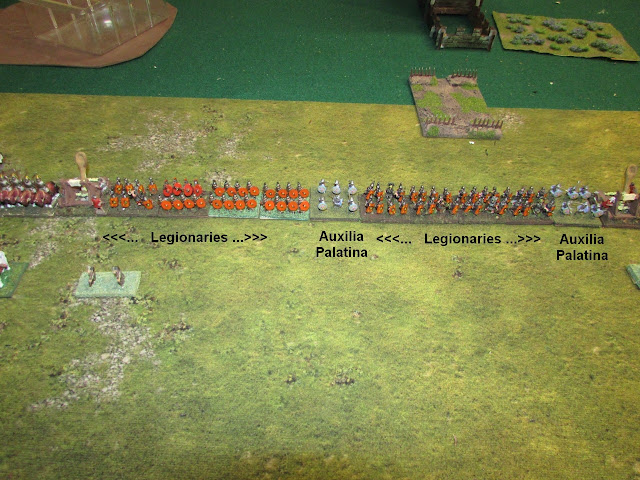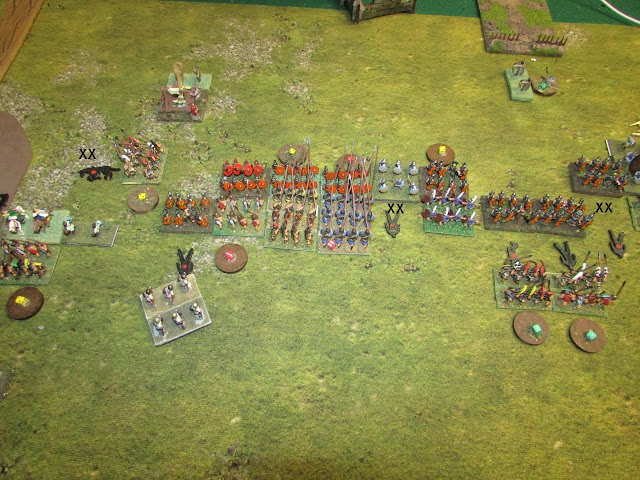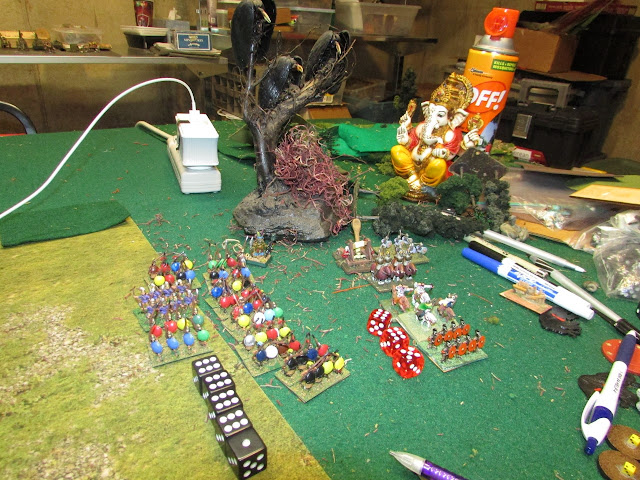A Headless Body Production
Venue: Another Undisclosed Downstairs
Event: Anno Domini 1666
Players: Phil Gardocki running Polish Nobles and their friends
Steve Turn running the King's Musketeers
Game System: Anno Domini 1666 by Wargamer Games Studio, Warsaw, Poland
The Forces:
The King's Musketeers with Aramis, Athos, Porthos and D'Artagnan.
The Polish Nobles with Colonel Pan Wolodyjowski, Longinus, Zagloba and Skrzetuski.
While the Polish characters are virtually unknown in the west, they are house hold names in Poland, and since Anno Domini 1666 is made in Poland, they are dominant characters in this game.
It is the year of our Lord 1666. Emperor Leopold is dead. The election looms. European monarchs send their envoys to Vienna to participate. But the struggle for the Empire's future takes place not only at the noble courts. In Vienna's slums and alleys swashbucklers, musketeers and thugs wage a secret war on behalf of their powerful superiors.
Anno Domini 1666 is a swashbuckling adventure game set with characters based on real-world history and famous novels.
I cannot play this game without music from Robin Hood and Zorro playing out in my head. Everything plays out like the massive swordplay scenes wrapping up these movies. The only thing missing seems to be a chandelier.
The game starts with cards defining your characters skills and equipment. Most are taken from famous literature, like the Three Musketeers, and from lesser known, in the West, Polish literature, Pan Wołodyjowski. A lot of the skills are directly combat related, but some are not. The Polish character Zagloba, is a drunk and a scoundrel. But is so charismatic, everyone is his friend.
This scenario follows on from the previous scenario, where the Polish Envoy's have managed to acquire the MacGuffin, (aka the sigel ring) It starts with Zagloba and Skrzetuski lurking in a Vienna slum, trying to get the sigel ring to a back room of a bar to a waiting homing pigeon. The other heroes of the story are guarding the bar.
But Athos and a nameless musketeer lie in wait in the shadows for an ambush. Their allies are covering all the other approaches to the bar.
 |
| Zagloba and Skrzetuski stagger onto the board. Athos and a movie extra cover the approaches to the bar. |
The Polish envoys have red rings around their bases, the Musketeers blue.
Zagloba has the ring. But Skrezetuski has a fake ring. The Musketeers do not know who has the real one.
 |
| An over exposed closeup of Zagloba and Skrezetuski doesn't do justice to Steve's paint job. |
 |
| An example of the card. The cards are of high quality stock. The various numbers display their various combat skills. The text (in Polish) their other skills. |
I like Zagloba, because of the skill "Call me Uncle" Which causes the other player to select a hero that was drinking with Zagloba the night before and is now his friend, and cannot attack or delay him. Worse, is still hung over and has a minus on his skills.
In this case, Porthos.
 |
| A better view of the board. Sir Wolodyjowski, and Longinus are having a drink at the bar, their Dragoons are outside, guarding the doors. |
 |
| Athos leaps from the shadows! His rapier strikes the heart of Skrzetuski before he is even aware he is there. Zagloba dives into the nearby house, and excuses himself to the no-longer-sleeping family. His manner is courteous and delightful. This is not their first drunk to stagger in late at night. |
 |
| Skrzetuski, however is very well armored, and Atho's rapier bends, but does not penetrate. |
 |
| Athos and Skrzetuski now trade swords, saber on rapier. Zagloba apologizes to the family, gives a quick nod to Skrzetuski, a rude gesture to Athos, and departs into the shadows. |
 |
| In response to Atho's messengers, Aramis and D'Artagnan arrive from their hiding spots. The Bar is surrounded. |
There is a loud bang of a musket being fired. All the slum is now awakened.
The number of turns in Anno Domini 1666 is variable. There are a series of counters about 16 from the looks of the pile. When the pile is depleted, the game is over, as this means the Viennese gendarmes are now alerted and investing the area in force, preventing an further mayhem.
Shooting a musket removes a turn counter, killing a character removes another. And once counters start depleting, one per turn till games end.
The shot narrowly misses Skrzetuski and straightens left side curl of Athos' mustache.
 |
| Porthos arrives, ignoring his newest drinking buddy, and moves to attack Skrzetuski. The movie extra, desperate for face time in this movie, closes in as well. |
 |
| But the Polish have the initiative this round, and Skretuski uses it to good effect. |
He savagely attacks Porthos with a pummel shot to the head (4 hits!) forcing him back. This gives Athos an opening, but Skrzetuski has a parry, then a riposte, and both characters are forced to retreat.
If you win and wound your opponent, he retreats, if neither are wounded, both retreat. If you cannot retreat, you test or fall. This comes up later.
 |
| Another shot in the dark from a Polish half musket (Polmuszkiet). Lightly wounding the nameless musketeer. |
I like the Half Muskets, as they can reload faster. When you get a full troop of them, the difference is amazing at short range. At long range the true muskets have the advantage.
 |
| Aramis has a decision to make. Assist Athos, or assault the bar. He decides Athos can take care of himself and with the help of another musketeer, assault the bar. |
 |
| Sir Wolodyjowski sends his friend Longinus to escort Zagloba to the bar, and exchanges swords with D'Artagnan. |
An let the Errol Flynn music play. These are the finest swordsmen in the game.
 |
| Slash, miss, parry, riposte, stab and break. Both men now have a measure of their foe, and take a step back for a breather. |
 |
| The Musketeer draws his sword, the Dragoon, his Waloon Sword. Until this is resolved, Zagloba cannot go forward. |
 |
| Longinus approaches from behind the Dragoon, and the Musketeer is momentarily distracted. The Dragoon stabs, forcing the Musketeer back, and holding his side, flees down the alley. |
The Musketeer had a minor wound earlier, and the Dragoon put another one on him. causing a morale check.
 |
| Skrzetuski and Athos continue their exchange, but now only halfheartedly. |
In this game the randomizers are cards. And if you get a card of low value, you can add to them from cards in your hand. Steve realized by this time that the McGuffin wasn't on Skrzetuski, and Athos didn't need to win this fight, and wasn't going to waste good cards in his hand on the fight.
Skrzetuski was so well armored, I didn't need to.
 |
| Aramis kicks in the door. Shots are exchanged. |
 |
| D'Artagnan and Wolodyjowski continue their sword play. |
 |
| Two more movie extras die, leaving the hero to enter the doorway unopposed. |
 |
| Cue more Errol Flynn music. |
 |
| In classic movie fashion, the hero leaves his one fight, to enter another! Sir Wolodyjowski now faces off with Aramis! |
 |
| Giving Longinus a chance at D'Artagnan. It's 2 handed sword vs rapier. |
Longinus is stabbed in the theigh, then crashes into the fence, tripping over the scattered wood.
A bleary eyed Porthos unsteadily approaches the nameless Dragoon. Who fails his reload attempt, and goes toe to toe with a hero. Miraculously he wins. Porthos flees.
 |
| His gun reloaded, the Dragoon chases Porthos into the alley and fires. |
 |
| He came back bragging a kill, but at that point Porthos was just barfing his guts out, and was no longer a threat. |
 |
| Athos retreats and Skrzetuski follows. |
 |
| Aramis and Wolodyjowski hold the door. |
 |
| Longinus gets up, and D'Artagnan continues his onslaught, wounding him again. |
 |
| When Aramis retreated, Wolodyjowski realizes his mistake and engages D'Artagnan again. |
But frantic police whistles are closing fast from all directions. The Gendarmes have arrived. Opponents realize their opportunities were lost and all retreat into the shadows towards the safety of their consulates.
"This is the most fun I've had, since the world was young."
--Alan Swan, played by Peter O'Toole, acting as Errol Flynn










































































